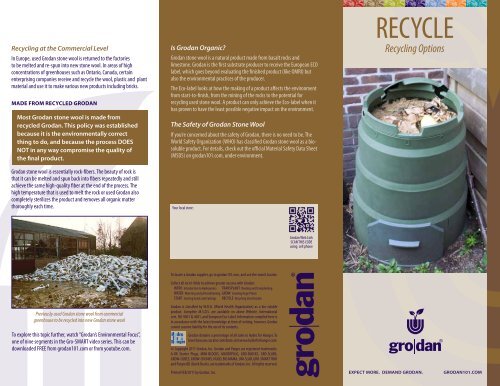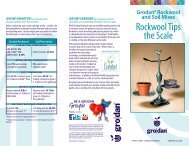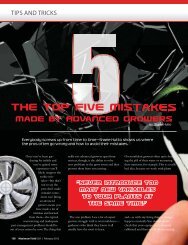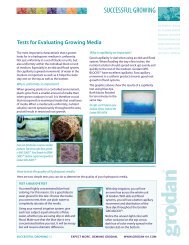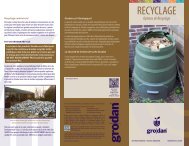RECYCLE - Grodan 101
RECYCLE - Grodan 101
RECYCLE - Grodan 101
Create successful ePaper yourself
Turn your PDF publications into a flip-book with our unique Google optimized e-Paper software.
Recycling at the Commercial Level<br />
In Europe, used <strong>Grodan</strong> stone wool is returned to the factories<br />
to be melted and re-spun into new stone wool. In areas of high<br />
concentrations of greenhouses such as Ontario, Canada, certain<br />
enterprising companies receive and recycle the wool, plastic and plant<br />
material and use it to make various new products including bricks.<br />
Made from recycled <strong>Grodan</strong><br />
Most <strong>Grodan</strong> stone wool is made from<br />
recycled <strong>Grodan</strong>. This policy was established<br />
because it is the environmentally correct<br />
thing to do, and because the process DOES<br />
NOT in any way compromise the quality of<br />
the final product.<br />
<strong>Grodan</strong> stone wool is essentially rock-fibers. The beauty of rock is<br />
that it can be melted and spun back into fibers repeatedly and still<br />
achieve the same high-quality fiber at the end of the process. The<br />
high temperature that is used to melt the rock or used <strong>Grodan</strong> also<br />
completely sterilizes the product and removes all organic matter<br />
thoroughly each time.<br />
Is <strong>Grodan</strong> Organic?<br />
<strong>Grodan</strong> stone wool is a natural product made from basalt rocks and<br />
limestone. <strong>Grodan</strong> is the first substrate producer to receive the European ECO<br />
label, which goes beyond evaluating the finished product (like OMRI) but<br />
also the environmental practices of the producer.<br />
The Eco-label looks at how the making of a product affects the environment<br />
from start-to-finish, from the mining of the rocks to the potential for<br />
recycling used stone wool. A product can only achieve the Eco-label when it<br />
has proven to have the least possible negative impact on the environment.<br />
The Safety of <strong>Grodan</strong> Stone Wool<br />
If you’re concerned about the safety of <strong>Grodan</strong>, there is no need to be. The<br />
World Safety Organization (WHO) has classified <strong>Grodan</strong> stone wool as a biosoluble<br />
product. For details, check out the official Material Safety Data Sheet<br />
(MSDS) on grodan<strong>101</strong>.com, under environment.<br />
Your local store:<br />
<strong>RECYCLE</strong><br />
Recycling Options<br />
<strong>Grodan</strong> Web Link<br />
SCAN THIS CODE<br />
using cell phone<br />
To locate a <strong>Grodan</strong> supplier, go to grodan<strong>101</strong>.com, and use the search locator.<br />
Previously used <strong>Grodan</strong> stone wool from commercial<br />
greenhouse to be recycled into new <strong>Grodan</strong> stone wool<br />
To explore this topic further, watch “<strong>Grodan</strong>’s Environmental Focus”,<br />
one of nine segments in the Gro-SMART video series. This can be<br />
downloaded FREE from grodan<strong>101</strong>.com or from youtube.com.<br />
Collect all six tri-folds to achieve greater success with <strong>Grodan</strong>:<br />
INTRO Introduction to Hydroponics TRANSPLANT Rooting and Transplanting<br />
WATER Watering and pH Conditioning GROW Growing Huge Plants<br />
START Starting Seeds and Cuttings <strong>RECYCLE</strong> Recycling Used <strong>Grodan</strong><br />
<strong>Grodan</strong> is classified by W.H.O. (World Health Organization) as a bio-soluble<br />
product. Complete M.S.D.S. are available on above Website. International<br />
cert. ISO 9001 & 4001, and European Eco-Label. Information compiled here is<br />
in accordance with the latest knowledge at time of writing; however, <strong>Grodan</strong><br />
cannot assume liability for the use of its contents.<br />
<strong>Grodan</strong> donates a percentage of all sales to Hydro for Hunger. To<br />
learn how you can also contribute, visit www.hydroforhunger.com.<br />
© Copyright 2011 <strong>Grodan</strong>, Inc. <strong>Grodan</strong> and Pargro are registered trademarks.<br />
A-OK Starter Plugs, MINI-BLOCKS, MACROPLUG, GRO-BLOCKS, GRO-SLABS,<br />
GROW-CUBES, GROW-CHUNKS, HUGO, BIG MAMA, UNI-SLAB, GRO-SMART TRAY<br />
and Pargro QD (Quick Drain), are trademarks of <strong>Grodan</strong>, Inc. All rights reserved.<br />
Printed FEB/2011 by <strong>Grodan</strong>, Inc.<br />
EXPECT MORE. DEMAND GRODAN.<br />
GRODAN<strong>101</strong>.COM
<strong>RECYCLE</strong> Recycling Options<br />
Protecting and Preserving the Environment<br />
Today people are more aware than ever before, of the importance of<br />
protecting and preserving the earth - and with legitimate reasons. But<br />
what many do not know is that growing hydroponically is far better for the<br />
environment than traditional growing methods. Want to know the reasons?<br />
• In hydroponics, one grows in a closed system where nutrients are<br />
recycled to the plant. In traditional soil growing, nutrients end up in<br />
the environment instead, polluting drinking water.<br />
• By using hydroponic re-circulating systems, the grower conserves up to<br />
75% on water usage, compared to traditional growing.<br />
• When using a soil-less hydroponic media, plants grow out of a clean,<br />
pathogen-free product, resulting in fewer disease, and the process of<br />
growing therefore requires 90% less pesticides.<br />
• In hydroponics, fertilizer is used only in half strength and at lower<br />
quantities. A commercial grower in soil can easily reduce his volume of<br />
fertilizer usage by 75% by switching from soil to hydroponics.<br />
• <strong>Grodan</strong> produces a large proportion of <strong>Grodan</strong> from recycled <strong>Grodan</strong>.<br />
Help the environment by personally recycling your <strong>Grodan</strong>, too!<br />
Environmental and Quality Certifications<br />
In addition to the above, <strong>Grodan</strong> factories receive the international<br />
environmental management rating ISO<br />
4001, ISO 9001 and the European ECO label.<br />
Unlike the North American OMRI that strictly<br />
looks at the product material, ECO label<br />
goes beyond and also evaluates the overall<br />
environmental practices of the producer<br />
and the entire life-cycle from raw material<br />
extraction to end disposal.<br />
Visit www.eco-label.com for more details.<br />
EU Ecolabel : NL/29/001<br />
Recycling Methods<br />
Crop Rotations<br />
This is one of the most popular recycling methods. Local farms benefit from<br />
crop rotation, and the same is true for home gardens.<br />
1. Grow a vegetable plant. Chop up the used GRO-SLAB/GRO-BLOCK into<br />
smaller 1/4” cubes, let them dry, then remove loose root mass.<br />
2. Compost your old plant and the root mass, and grow flowers in the<br />
chopped cubes.<br />
3. When you are tired of the flower, remove the plant and the loose root<br />
mass and pot up a foliage or house plant in the used cubes.<br />
4. Once the house plant has expired, remove the plant and the loose root<br />
mass and grow a new plant or mix into a garden bed.<br />
For seeds and cuttings, always use new <strong>Grodan</strong> starters because used stone<br />
wool will have too many roots. So in this instance, it is better to chop them up<br />
and use as a potting mix.<br />
wood-chipper granulate<br />
Turn used stone wool into granulate by running it through a wood chipper.<br />
Attach a plastic ‘tent’ to catch the chipped wool, then use the granulate in<br />
several different ways.<br />
• To speed up composting, add some granulate each time you add<br />
kitchen food debris. The stone wool aerates the compost and speed up<br />
the decomposition process by 20-30%.<br />
• To improve the tilth of regular garden soil, Whenever using<br />
add 30% wool to the top 1.5 feet of soil, and previously-used<br />
mix it in.<br />
stone wool in this<br />
• To improve sandy and clay soils, mixing<br />
manner, don’t<br />
granulate in with these difficult soils will<br />
forget to add<br />
enable quicker plant growth the next time<br />
fertilizer. Consider<br />
around. Add the granulate into the hole when<br />
using slow-release<br />
planting in your garden. You will be amazed<br />
granules specifically<br />
at how much faster it grows.<br />
in containers.<br />
• Use the granulate as a potting substrate for<br />
potted plants.<br />
FLOOD BARRIERS from old slabs<br />
Due to the absorption properties, stone wool works well as a flood<br />
barrier.<br />
• First, always remove the plastic and use the previously used<br />
GRO-SLABS in place of sand bags.<br />
• Stack in a double staircase shape and seed grass on the slabs, so<br />
they look nice outside of the flood season.<br />
Will Stone Wool Decompose in my Garden?<br />
Stone wool is a bio-soluble product. It will dissolve (disappear) at low<br />
pH, but not at the typical pH level in gardens.<br />
Keep in mind that stone wool consists of rock-fibers, so they will in<br />
time separate more as you work the soil. However like the rocks in<br />
a garden, the fibers will never just disappear, but will become less<br />
visible as they break down<br />
into minerals.<br />
BASIC ADVANTAGES<br />
There are two great advantages to mixing stone wool into your garden.<br />
1. It keeps the soil light and easy to work with for 5-9 years.<br />
2. Stone wool will always improve the soil.<br />
• In clay soil, stone wool adds air.<br />
• In sandy soil, stone wool helps retain more water.<br />
• In silt or loamy soil, adding stone wool allows the plant to<br />
stay happy with less frequent watering. Stone wool also helps<br />
alleviate the hard surface tension when the soil dries out,<br />
making it easier to re-wet as needed.<br />
Raised garden bed from old slabs<br />
• First, always remove the plastic.<br />
• Stack the slabs outside to make a raised bed garden.<br />
• Do not stack more than four slabs high because any more will dry out<br />
and possibly fly off.<br />
EXPECT MORE. DEMAND GRODAN.<br />
GRODAN<strong>101</strong>.COM


